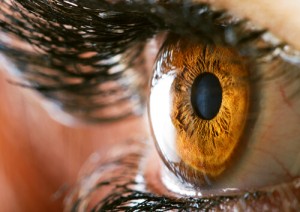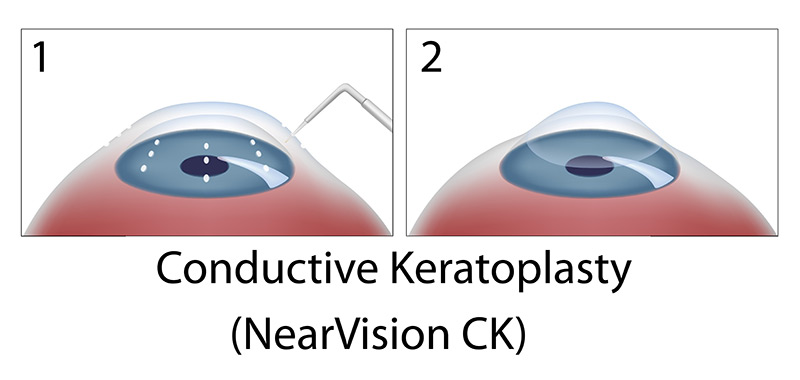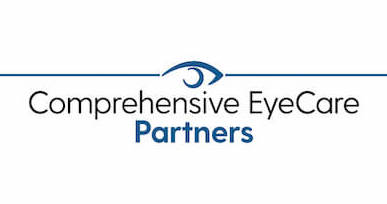
Conductive Keratoplasty (CK) is the only FDA approved, non-laser treatment specifically designed for people who are farsighted (better vision at distance than near). Conductive Keratoplasty can help restore your vision, allowing you to see clearly as you could 10 years ago. It’s an exciting new advancement in vision correction because it uses radiofrequency (RF) energy instead of a laser to treat your vision problem. It is a quick, safe, minimally invasive, and effective treatment performed right in our office and you could be a candidate if you:
- Are tired of being tied to bifocals
- Find that your arms just are not long enough for you to read the newspaper clearly
- Find yourself more dependent on your glasses than ever before
Dr. Robert Taylor is among the first group of surgeons in the country to offer Conductive Keratoplasty. Call the office for more information or to schedule an appointment (702) 731-2088.
How is CK performed?

CK uses radio waves, the controlled release of radiofrequency (RF) energy, instead of a laser, to reshape the cornea. CK is performed using a small probe, thinner than a strand of human hair, that releases radiofrequency (RF) energy. The probe is applied in a circular pattern on the outer cornea to shrink small areas of corneal tissue. This circular shrinkage pattern creates a constrictive band (like the tightening of a belt), increasing the overall curvature of the cornea. The procedure, which takes less than three minutes, is done in-office with only topical anesthesia (eye drops).
Will you cut the cornea?
No. CK is performed without the cutting or removal of tissue. It is a safe, minimally invasive procedure for farsightedness.
Is radiofrequency (RF) energy safe for use on the eye?
Yes. The use of RF energy is one of today’s most advanced surgical techniques. In addition to its use in CK, RF technology is being used in prostate cancer therapy, back surgery, even cardiovascular procedures.
Will my vision improve immediately after surgery?
Patients usually notice an immediate improvement in their vision after the CK procedure. However, it usually takes several weeks for the eyes to adjust to the final level of treatment.
Will my vision fluctuate after surgery is performed?
Most patients will experience mild fluctuation in their vision after surgery, but few notice it. Any fluctuation will usually subside within a few weeks. Patients who are treated for hyperopia, regardless of the procedure, usually require a longer stabilization period than those treated for myopia.
Are both eyes treated on the same day?
For patients who require treatment in both eyes, CK is typically performed on both eyes on the same day – one eye immediately after the other. Most patients are comfortable having the CK procedure performed on both eyes on the same day because the procedure is minimally invasive, takes less than three minutes and is done in-office with only topical anesthesia.
Will I have to wear patches over my eyes after the procedure?
You will not have to wear patches or bandages, however, many surgeons will recommend temporary clear lenses (similar to contact lenses but without a prescription) to protect the eyes and to reduce any potential discomfort.
How soon can I return to work?
With CK, the majority of patients are able to return to work and other normal activities the day of their procedure. Although recovery is fairly quick, it is advisable to be careful with your eyes and to avoid any strain. Those whose jobs demand intense clarity of vision (such as dentistry, surgery or computer work) may want to give their eyes some extra rest for several days following the procedure before getting back to work.
What will I feel during the CK procedure?
The CK procedure is considered painless. You will be aware of support (speculum), which helps to hold your eye open. The most common sensation that patients experience is a feeling of pressure on the eye. After surgery, there may be some mild discomfort, and many patients experience a foreign-object sensation or a slight “scratchiness” in the eye. This usually subsides within 24 hours of the procedure.
What type of anesthesia is used during the CK procedure?
A local anesthetic in the form of eye drops is used to numb the eye. Some patients who are very nervous and have a high level of anxiety about the procedure will be given a mild sedative to help them relax.
Why doesn’t CK use a laser?
CK is the first alternative to laser for farsightedness. Rather than removing tissue with a laser, CK reshapes the cornea using an entirely different method: the application of low-level, radiofrequency (RF) energy applied in a circular pattern on the outer cornea, to shrink small areas of corneal tissue. This circular pattern acts like a belt-tightening around the cornea to increase its overall curvature. The procedure, which takes less than three minutes, is done in-office with only topical anesthesia (eye drops).
Will the instrument used in the CK procedure penetrate my cornea?
CK is performed using a probe (Keratoplast™ Tip) that is as thin as a strand of human hair. The probe, introduced into the cornea, applies controlled radiofrequency (RF) energy, stabilizes the CK procedure and guarantees the precise depth of treatment.
What are the risks and side effects of Conductive Keratoplasty?
Because CK is minimally invasive and extremely precise, the procedure has exhibited very minimal risk and almost no side effects. During the first 24-48 hours after CK, you may experience tearing and some discomfort, including a foreign-object sensation in the eyes. You may also experience an initial slight over-correction of your vision, which stabilizes during the following weeks. However, because CK doesn’t cut or remove tissue, many of the side effects associated with other vision treatment procedures have not been observed with CK.
Are there restrictions after having CK?
As with any vision treatment procedure where the cornea is altered, certain precautions should be taken. After the CK procedure, patients should avoid getting contaminated water in their eyes for at least one week. This includes water from swimming pools, spas, lakes, and the ocean. When showering or taking baths, patients should keep their eyes closed in order to avoid getting soap and dirty water into their eyes. When exercising, sweat should be kept out of the eyes for at least a week after surgery. Also, patients should avoid rubbing the eyes vigorously for two weeks following the procedure. Females should also avoid applying eye makeup for one week after surgery.
Am I guaranteed 20/20 vision following CK?
No. And no honest surgeon can absolutely guarantee a certain result from any vision treatment procedure. At this time, nearly 95% of patients with low to moderate ranges of hyperopia achieve normal or near-normal vision after CK.
Will I ever need glasses or contacts again?
The vast majority of patients do not need corrective lenses of any kind after the CK procedure. However, depending on your age and the type of refractive disorder you have, you may need additional vision treatment at some point (surgery, reading glasses or bifocals). This is because your eyes continue to change as you age, and no one can avoid presbyopia, the natural result of aging that occurs when the lens in your eye loses flexibility.
Can CK treat myopia (nearsightedness)?
CK was designed for hyperopia, or farsightedness, where the cornea requires steepening. CK is not designed to flatten the cornea, the effect required for the treatment of myopia.
Is CK reversible?
As with most vision treatment procedures, CK is not reversible. Once the procedure has been performed, it is not possible to “remove” its effects. This is an important factor for anyone thinking about surgery to carefully consider. To make sure CK is right for you, seek the advice of your surgeon.
Why did the FDA approve CK for the “temporary” treatment of hyperopia?
The FDA has recently changed its guidelines for stability because hyperopia is a progressive disease, which means as people age their level of farsightedness will increase – with or without surgical treatment. It’s for this reason that the FDA defines even hyperopic LASIK as temporary.
Will my health insurance cover the cost of the CK procedure?
Because CK is considered elective surgery (cosmetic), most health insurance plans do not cover it. Financing options are available to make CK more affordable. For more information about financing, ask our financial counselors at The Shepherd Eye Center.
Who is CK right for?
CK has been approved for patients with mild to moderate hyperopia (up to +3.00 diopters). The following are some basic criteria you must meet to be considered a good candidate for CK:
- Be at least 40 years of age
- Have no drastic changes in vision or eyeglass prescription within the past year
- Have no eye conditions such as glaucoma, severe dryness, keratoconus, herpes of the eye, aggressive keloid formation or corneal dystrophy
- Have no physical conditions such as diabetes, pregnancy or nursing, and vascular or autoimmune diseases
To determine if you are a candidate for CK, schedule an appointment with Dr. Taylor at 702-731-2088.
How is a precise amount of RF energy and depth of treatment ensured during the CK procedure?
The ViewPoint™ CK System was engineered and designed specifically for the CK procedure. This means that the precise amount of RF energy needed to affect the corneal tissue, at the precise tissue temperature and depth of treatment, were meticulously investigated and defined. The Keratoplast™ Tip penetrates the cornea to a depth of 450 um and utilizes a Teflon® plastic stop at the very distal portion to assure precise depth of penetration.
What is the risk of the collagen being overheated and causing scarring?
The risk of the collagen being heated above the optimal or permanent shrinkage temperature is almost nonexistent with the CK system. Comprehensive thermal modeling and long-term clinical effectiveness and stability data ensure that the system consistently and accurately reaches the appropriate temperature to induce optimal tissue shrinkage.
Can CK be performed on patients who have a pacemaker?
The CK equipment can produce interference that may adversely influence the operation of other electronic equipment. Therefore, CK is not recommended for patients who are wearing a pacemaker.
What enables CK to be performed in-office?
CK is a minimally invasive procedure that does not require cutting of the cornea and therefore does not carry the associated risks or surgical complications. The procedure is relatively quick and easy to perform – taking an average of just 3 minutes.
CK (Conductive Keratoplasty) – Differentiating Presbyopia
Near Vision CK (for presbyopia) applies radiofrequency energy in a circular pattern on the outer cornea to shrink small areas of collagen. This is done with a small probe. This shrinking pattern creates a constrictive band (like the tightening of a belt) increasing the overall curvature of the cornea to bring near vision back into focus. CK greatly reduces the dependency on reading glasses. Patients are able to look at their watch, dial their cell phones, put on make-up and read menus without always having to reach for the reading glasses. They will still need to wear reading glasses for some tasks. Reading a line print book for a long period of time will still require reading glasses. It will also compromise distance vision a little in the eye being treated. The visual outcome of the procedure can be explained as a “two eye” procedure. Both eyes need to be open to achieve the optimal outcome. CK is not a permanent procedure and will usually need to be re-done in approximately 2-3 years. CK is non-invasive; there is no cutting of tissue or laser surgery.
CK (Conductive Keratoplasty) – Differentiating Hyperopia
Just like LASIK or PRK, CK can also correct farsightedness. This procedure is normally used on patients with small amounts of farsightedness, under 3.00 diopters. CK for farsightedness is normally done on both eyes. Although CK for presbyopia is usually done on only one eye there are cases where patients need both eyes done. This happens when a patient has a small refractive error in the other eye. A small amount of CK will be done on this eye (the dominant eye) to make it better for distance while the non-dominant eye will be treated for the near vision.


